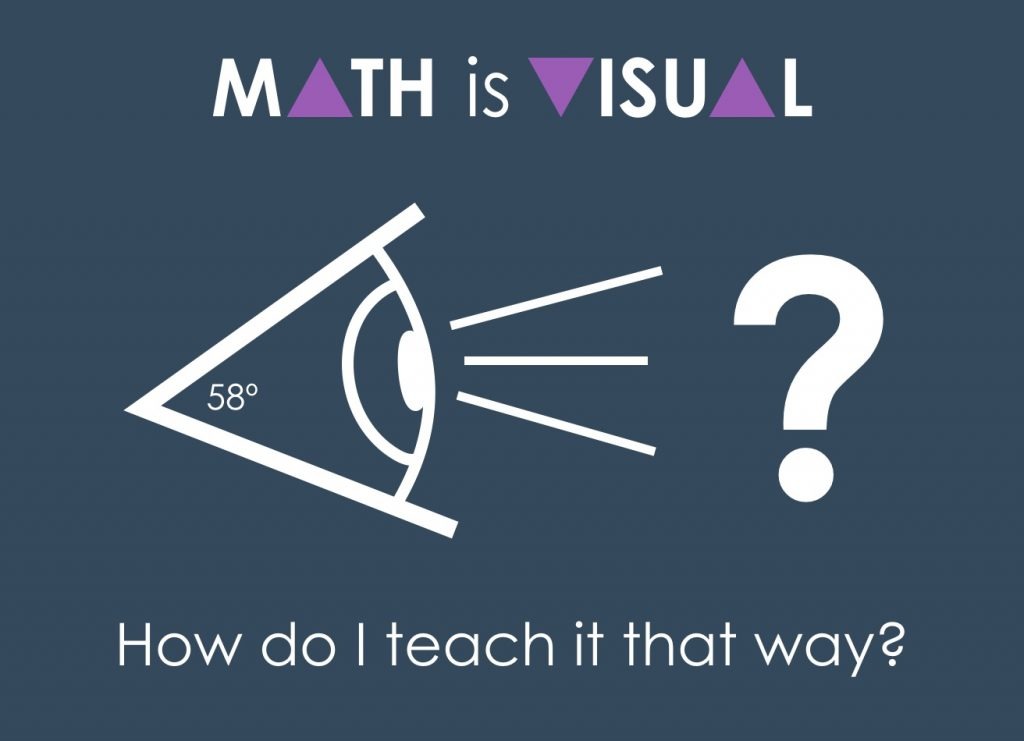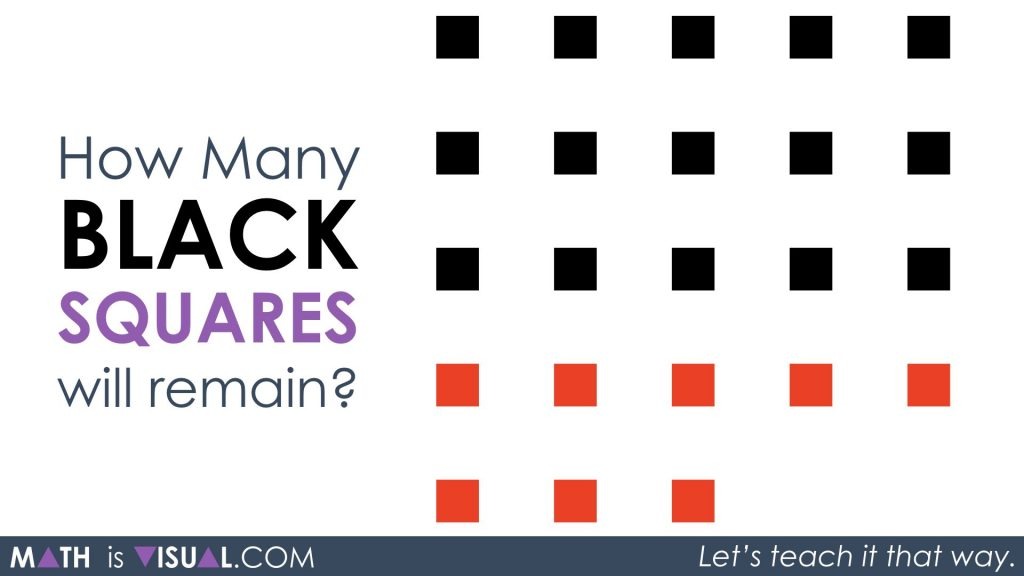
So I keep saying “Math is visual. Let’s teach it that way!”
That’s great and all. But what if you’re not sure where to start?
You’ve come to the right place!

While you are free to use the MathIsVisual.com website and resources in any way you feel would be most useful, I’d like to take a moment to share how I visualized this tool being used by teachers with their students in a classroom setting as well as parents with their children at home.
1. Watch Math Is Visual Video Prompt
Every Math Is Visual video prompt takes a visual approach to help model for teachers, parents and students an intuitive way to think about a mathematical idea.
The goal is to lead the viewer down a very carefully planned inquiry pathway so the construction of conceptual understanding will take place along the way while working towards the development of procedural fluency over time.
2. Take Time To Notice and Wonder
Consider pausing the video as often as useful and/or necessary to ask your students or children what they notice and what they wonder.
For example, after each segment of a video, you’ll notice that all objects will clear off the screen before introducing the next visual. This would be a great time to hit the pause button, scroll back in the video a little bit and hear what your kids are thinking after that section.
I am often surprised at how much kids know based on their intuition and prior experience from the world around them. Be sure to honour what they notice and wonder by acknowledging their thinking, asking clarifying questions or mention something you notice or wonder related to their ideas.
3. Give a Challenge
Throughout each Math Is Visual Video Prompt, I attempt to give the viewer something to think about based on what they have watched so far.For example, in the following integer addition visual video prompt, the viewer is presented with a number of animations to implicitly introduce the zero principle:
After having some time to ponder this new idea, the viewer is presented with a challenge of their own. In this case, the viewer is given another visual to consider and is asked:
How many black squares will remain?

This challenge will not only give the viewer an opportunity to engage in a productive struggle, but will also give you as the teacher or parent an opportunity to determine whether there is more playing necessary in this area before moving on.Something to note for teachers is that we are trying to introduce mathematical ideas from the approach of concreteness fading; starting with concrete (i.e.: using physical square tiles to work through mathematical ideas), progressing to visual representations (i.e.: drawings and digital visuals) and then finally, introducing the symbolic representation (i.e.: using numbers and mathematical symbols that represent the concrete/visual representations).
4. Discuss, Consolidate and Extend
Be sure to engage in a lot of conversation with your students and/or children as you work through these activities. Attempt to consolidate some of the key ideas as you see them and extend ideas if you find that the challenge given in the visual video prompt was not cognitively demanding enough for the viewer.Unsure how to consolidate or extend the concept? Never fear! For the vast majority of us, we were taught primarily from a procedural perspective in math class and using visuals really pushes our conceptual understanding. That means that even some of the supposedly “easy” math topics might actually seem more difficult to consolidate or extend. If that is the case, don’t hesitate to lean on myself, your colleagues, or the Google Machine!
Using Math Is Visual With My 5- and 3-Year Old Children
While referencing the 4 ideas above can be helpful, I think seeing examples of how Math Is Visual has been used in different situations can be helpful.
Here is a short video of my 5-year old daughter, Taliah and her 3-year old brother, Landon engaging in a Math Is Visual Video Prompt involving the addition of integers. In the Ontario math curriculum, this is a concept that is explicitly introduced in grade 7, however I was able to engage a pre-schooler and a kindergartener in some pretty interesting mathematical discourse by giving them an entry point by using visuals.
Have a look at the video below:
Wow, pretty amazing, right?
You can quickly see that 5-year old Taliah is able to subitize numbers to about 5, while Landon is still working on subitizing numbers larger than 3.
After only a few visual prompts, Taliah has conceptualized that when a black square and a red square are put together, they disappear. This is exactly what I had in mind when I created these particular integer visual video prompts; the implicit introduction of the zero principle using concrete and/or visual representations (i.e.: square tiles) before introducing the symbolic notation (i.e.: 15 + (-8) = 15 – 8 = 7).
Landon, on the other hand, is still working on one-to-one correspondence when numbers get larger than about 8 and subitizing numbers larger than 3.
With this particular Math Is Visual experience, I anticipated my kids only really being able to count the squares using one-to-one correspondence and conceptual subitizing. However, the visual nature of the prompts lowered the floor on integer arithmetic that many grade 7 students find difficult to work with using symbols alone.
You can find the two Math Is Visual Math Prompts for Adding Positive and Negative Integers by clicking here and here.
Using Math Is Visual With Middle and High School Students
While these visuals can be used as a warm-up using a routine like a math talk or mini-lesson, these resources can be used across various grade levels. As I continue to build out the site, it is my aim to create content that spans the K-12 curriculum and thus the resources can be used in middle and high school grades as well.
Here’s a note I received recently from a teacher who is using Math Is Visual in Algebra 1:
Good morning!
I am a high school math teacher, Algebra 1, teaching students with learning issues and those repeating the subject.
I have begun by using your videos as Number talks, starter activities that help build mathematical discussion.
Your visuals give everyone an entry point. Many times I’ve found it is the lack of confidence in small math facts that cause children to struggle with more advanced concepts. This is a great way to revisit and practice to support scaffolding of material at grade level.
Thank you for these resources.
Clara Maxcy
Special thanks to Clara for sharing her experiences using Math Is Visual thus far!
Although Clara mentions that she is working specifically with students who have learning difficulties and those who are repeating the subject, we must realize that some of those who go “under the radar” also have gaps in their conceptual understanding. You might consider using some of the visual prompts to help solidify the understanding of your group as a whole to avoid what I like to call “the wheels falling off” in their later learning.
Have you used any of the Math Is Visual Video Prompts with your students at school or with your children at home?
I’d love to see how you used them and if you are comfortable, I would love to share your story with the community.
Math is visual. Let’s teach it that way.

